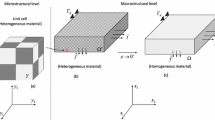Abstract
A fiber-reinforced composite material \(\mathcal {N}\) consists of a matrix and numerous fibers. Besides their intrinsic properties and the volume fractions of matrix and fibers, the effective elasticity tensors of \(\mathcal {N}\) are also related to the two-dimensional (2D) or the three-dimensional (3D) fiber direction distributions. Herein the Fourier series and the Wigner D-functions are introduced as the 2D and the 3D fiber direction distribution functions (FDF), respectively. The expanded coefficients of the FDF are called the fiber distribution coefficients (FDC). When \(\mathcal {N}\) consists of an anisotropic elasticity matrix and numerous transversely isotropic fibers, we derive the effective elasticity tensor \(\widehat{\mathbf {C}}\) of \(\mathcal {N}\) by the self-consistent method with the 2D FDC or the 3D FDC. The FDC can be easily obtained via the fiber direction arrangements of \(\mathcal {N}\) for the fiber arbitrary or orthorhombic distributions of \(\mathcal {N}\). The procedure of deriving \(\widehat{\mathbf {C}}\) is simple because the Kelvin notation is used to compute tensor rotations. When both the matrix and the fibers are isotropic, for the 2D fiber distributions at least three direction arrangements of fibers are needed to build the fiber-reinforced transversely isotropic composite materials, and for the 3D fiber distributions at least six direction arrangements are needed to build the fiber-reinforced isotropic composite materials. The results of the FEM simulations are consistent with those of our expressions \(\widehat{\mathbf {C}}\).


Similar content being viewed by others
References
Advani, S.G., Tucker, C.L.: The use of tensor to describe and predict fiber orientation in short-fiber composites. J. Rheol. 31(8), 751–784 (1987)
Müller, V., Böhlke, T.: Prediction of effective elastic properties of fiber reinforced composites using fiber orientation tensors. Compos. Sci. Technol. 130, 36–45 (2016)
Dong, X.N., Zhang, X., Huang, Y.Y., Guo, X.E.: A generalized self-consistent estimate for the effective elastic moduli of fiber-reinforced composite materials with multiple transversely isotropic inclusions. Int. J. Mech. Sci. 47, 922–940 (2005)
Hashin, Z., Rosen, B.W.: The elastic moduli of fiber-reinforced materials. J. Appl. Mech. 31, 223–232 (1964)
Hashin, Z.: On elastic behavior of fiber reinforced materials of arbitrary transverse phase geometry. J. Mech. Phys. Solids 13, 119–134 (1965)
Hill, R.: Theory of mechanical properties of fibre-strengthened materials-I. Elastic behavior. J. Mech. Phys. Solids 12, 199–212 (1964)
Hill, R.: Theory of mechanical properties of fibre-strengthened materials-III. Self-consistent model. J. Mech. Phys. Solids 13, 189–198 (1965)
Bunge, H.J.: Texture Analysis in Material Science: Mathematical Methods. Butterworths, London (1982)
Roe, R.J.: Description of crystallite orientation in polycrystalline materials: III. General solution to pole figures. J. Appl. Phys. 36, 2024–2031 (1965)
Roe, R.J.: Inversion of pole figures for materials having cubic crystal symmetry. J. Appl. Phys. 37, 2069–2072 (1966)
Lobos, M., Yuzbasioglu, T., Böhlke, T.: Materials design of elastic properties of multiphase polycrystalline composites using model functions. Proc. Appl. Math. Mech. 15, 459–460 (2015)
Lobos, M., Yuzbasioglu, T., Böhlke, T.: Homogenization and materials design of anisotropic multiphase linear elastic materials using central model functions. J. Elast. 128(1), 17–60 (2017)
Böhlke, T., Lobos, M.: Representation of Hashin–Shtrikman bounds of cubic crystal aggregates in terms of texture coefficients with application in materials design. Acta Mater. 67, 324–334 (2014)
Lobos, M., Böhlke, T.: Materials design for the anisotropic linear elastic properties of textured cubic crystal aggregates using zeroth-, first- and second-order bounds. Int. J. Mech. Mater. Des. 11, 59–78 (2015)
Fernändez, M., Böhlke, T.: Hashin–Shtrikman bounds with eigenfields in terms of texture coefficients for polycrystalline materials. Acta Mater. 165, 686–697 (2019)
Lobos Fernändez, M., Böhlke, T.: Representation of Hashin-Shtrikman bounds in terms of texture coefficients for arbitrarily anisotropic polycrystalline materials. J. Elast. 134, 1–38 (2019)
Huang, M.J., Man, C.-S.: A finite-element study on constitutive relation HM-V for elastic polycrystals. Comput. Mater. Sci. 2005(32), 378–386 (2005)
Huang, M., Zhan, H., Lin, X.Q., Tang, H.: Constitutive relation of weakly anisotropic polycrystal with microstructure and initial stress. Acta. Mech. Sin. 23, 183–198 (2007)
Morris, P.R.: Elastic constants of polycrystals. Int. J. Eng. Sci. 8, 49–61 (1970)
Huang, M.J.: Elastic constants of a polycrystal with an orthorhombic texture. Mech. Mater. 36, 623–632 (2004)
Huang, M.J.: Perturbation approach to elastic constitutive relations of polycrystals. J. Mech. Phys. Solids 52, 1827–1853 (2004)
Huang, M., Man, C.-S.: Explicit bounds of effective stiffness tensors for textured aggregates of cubic crystallites. Math. Mech. Solids 13, 408–430 (2008)
Varshalovich, D.A., Moskalev, A.N., Khersonskii, V.K.: Quantum Theory of Angular Momentum. Word Scientific, Singapore (1988)
Biedenharn, L.C., Louck, J.D.: Angular Momentum in Quantum Physics. Cambridge University Press, Cambridge (1984)
Man, C.-S., Huang, M.J.: A representation theorem for material tensors of weakly-textured polycrystals and its applications in elasticity. J. Elast. 106, 1–42 (2012)
Eshelby, J.D.: The determination of the elastic field of an ellipsoidal inclusion, and related problems. Proc. R. Soc. A241, 376–396 (1957)
Nemat-Nasser, S., Hori, M.: Micromechanics: Overall Properties of Heterogeneous Materials. North-Holland, Amsterdam (1993)
Mura, T.: Micromechanics of Defects in Solids. Martinus Nijhoff Publishers, The Hague (1982)
Man, C.-S.: On the constitutive equations of some weakly textured materials. Arch. Ration. Mech. 143, 77–103 (1998)
Acknowledgements
The work was supported by the Natural Science Foundation of China (11572147,51568046).
Author information
Authors and Affiliations
Corresponding author
Additional information
Publisher's Note
Springer Nature remains neutral with regard to jurisdictional claims in published maps and institutional affiliations.
Rights and permissions
About this article
Cite this article
Zhao, T., Zhang, L. & Huang, M. Effective elasticity tensors of fiber-reinforced composite materials with 2D or 3D fiber distribution coefficients. Acta Mech 230, 4175–4195 (2019). https://doi.org/10.1007/s00707-019-02485-w
Received:
Revised:
Published:
Issue Date:
DOI: https://doi.org/10.1007/s00707-019-02485-w



